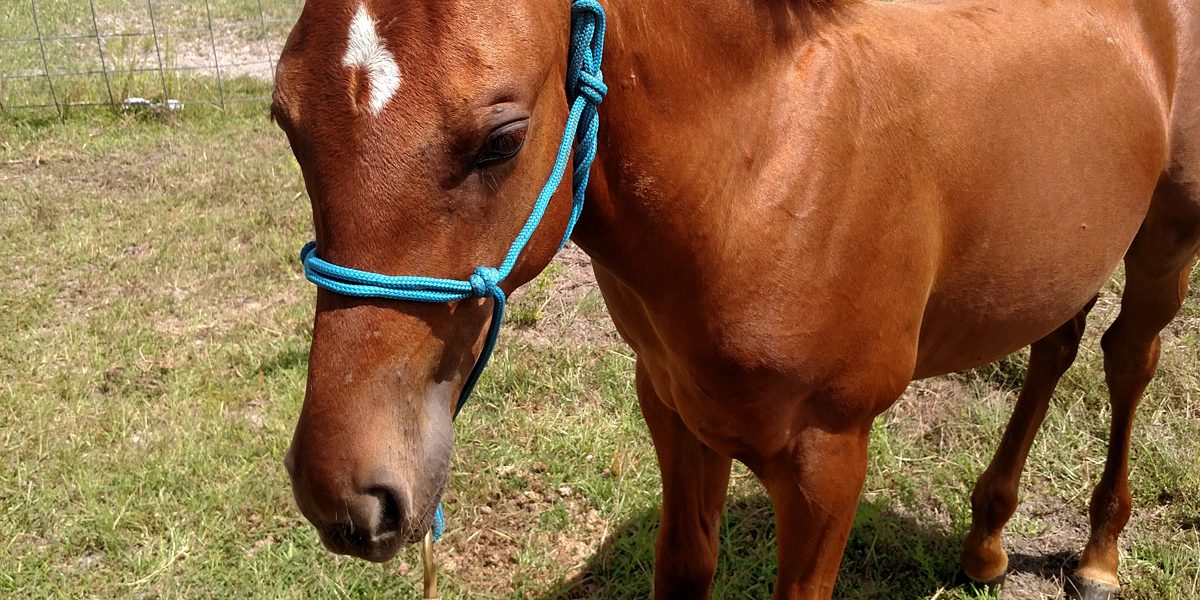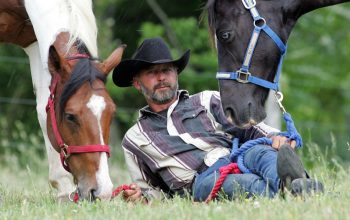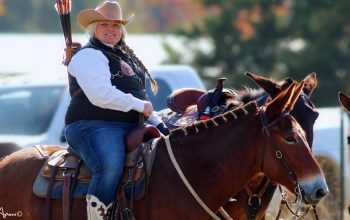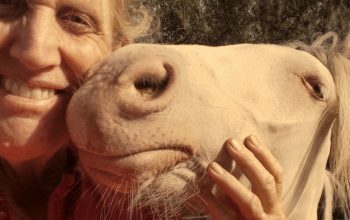“Ever tried leading your horse from the barn to the mounting block and it feels like you’re dragging a 1000 pound chair through the sand?!”
 As prey animals, horses are born to push against pressure. A colt will see what boundaries are laid before him, testing, flexing and bending them until his mama makes him aware of the truth…
As prey animals, horses are born to push against pressure. A colt will see what boundaries are laid before him, testing, flexing and bending them until his mama makes him aware of the truth…
Yield to me!
From the moment a foal is born, it is hard wired to push, and will continue to push until taught not to.
When I brought home a young rescue horse years ago, it became evident that she had never learned this. She was taken off her mama early and not socialized with other horses. Unfavorable behavior resulted and she pushed and pulled heavily on the young lady who was attempting to use her for 4H. The result was an unwanted, difficult horse who needed leadership and dedication to help her become a great horse. Most people give up when push comes to shove.
Most people are not trainers. They buy a horse that they expect to carry them throughout whatever endeavor they choose, whether recreational or competitive. A lot of horses do just fine. But sometimes the horse misses out on good mama parenting and/or human partnering training. When that happens, especially with a horse with a dominant personality, we end up with a horse we can’t even lead from point A to Point B without a struggle!
But if we learn some basic horse training skills, we can keep from getting frustrated or hurt, and prevent having to sell the horse.
Teach your horse to yield to poll pressure. You will do this by putting on pressure in small increments with your fingertips. First rub your horse gently between his ears near the halter. Then start to press with your fingers slowly until the horse lowers his head a little, releasing the pressure immediately when he does. Rub him gently in that spot, as if you’re erasing the touch. Repeat this until his head readily lowers with your touch.
Some horses will put their head up or pull away, trying to shake you off that spot. Without being aggressive, hang in there with your horse, drifting with him, until he relaxes and licks his lips. Licking and chewing means he is processing our request, so pause and allow him a moment to do so.
When he is finished processing, rub him, then begin again. One of the beautiful things about horses is there are plenty of do-overs allowed in training them! The goal is for him to be relaxed and trying to comply.
 I see a lot of horses that make no apologies for dragging their owners around. They love to grab grass and engage in a tug of war! The easiest way to get your horse’s nose to lift up and come to you, is to disengage the hindquarters. Put a steady feel on the leadrope, not a heavy pull, then, while staying safely out of the kick zone, look with intention at the horse’s hip. Using a training stick, start tapping the air above your horse’s hip with rhythm. If he continues to not move, then start tapping his hip until he steps his back legs over and away. He might try to step forward, so be ready to lift the leadrope and wiggle it up and down. As you communicate to him to yield his hind end and not step forward, suddenly, his nose, eyes, and ears will be on you! Pet him. Repeat this exercise until he willing lifts his head from eating grass without you having to lift your stick at all.
I see a lot of horses that make no apologies for dragging their owners around. They love to grab grass and engage in a tug of war! The easiest way to get your horse’s nose to lift up and come to you, is to disengage the hindquarters. Put a steady feel on the leadrope, not a heavy pull, then, while staying safely out of the kick zone, look with intention at the horse’s hip. Using a training stick, start tapping the air above your horse’s hip with rhythm. If he continues to not move, then start tapping his hip until he steps his back legs over and away. He might try to step forward, so be ready to lift the leadrope and wiggle it up and down. As you communicate to him to yield his hind end and not step forward, suddenly, his nose, eyes, and ears will be on you! Pet him. Repeat this exercise until he willing lifts his head from eating grass without you having to lift your stick at all.
Some horses are more sensitive than others and won’t need a lot of pressure, but others will be harder to convince! Always start off politely with a smile. Anger has no place with horses. Emotions will only get in the way of your progress. Simply follow through with patience and pressure until your horse tries to comply. Then thank him with a sincere rub. Remember that he is your friend, you’re just nipping him like his mama would!
Leading is understanding and responding appropriately to poll pressure. Always get your horse’s attention with your intention to go somewhere. Be aware and kind as you put a gentle feel on the rope. If he comes, do not pull on him. If he does not come along with a suggested feel, then you can add some pressure at his hip to encourage that nose to come along! Everything in increments, always releasing all pressure you have on your horse when he tries to make you happy.
Have a purpose to your steps, go somewhere with commitment. If you are hesitant, he will lose focus and begin to eat grass again. He might decide that he would rather hang at the barn with the other horses. Doesn’t matter. A horse will follow a strong leader. Remember there is a pecking order in every herd. You fall somewhere in that pecking order. Communicate like a horse, because then your horse will understand that you are not being mean to him, you are only asking for respect as one higher up on the pecking order.
A horse is like water in that he will always pick the path of least resistance. Water will always flow downhill, and a horse will give in when he sees how easy it is to comply with our wishes. Your horse will, at one time or another, play you! Horses are in it to win it…Natural Horsemanship skills will get you to where you can have fun playing and winning their game!

Horses instinctively look for leadership within the herd. A foal follows his mama everywhere, even after she nips him for being pushy! People are always amazed after they have become effective with pressure and their horse ends up even more bonded to them and following them around!
Understanding, communication and assertiveness will lead you to success!
—————————————————————————————–
By Nancy Slater, Horse Behavior Specialist
Licensed 2 Star Parelli Professional
www.nancyslater.com
 Nancy Slater is a Parelli Professional who has dedicated her life to making the world a better place for horses and the people who love them. Her self-less passion for educating kids as well as demonstrating how a real partnership with your horse can lead to competitive success is what makes Nancy stand out. We could not be more proud to be represented by Nancy as she helps us to teach horse riders, trainers and owners to use love, language and leadership to reach their goals with horses. Thank you Nancy!
Nancy Slater is a Parelli Professional who has dedicated her life to making the world a better place for horses and the people who love them. Her self-less passion for educating kids as well as demonstrating how a real partnership with your horse can lead to competitive success is what makes Nancy stand out. We could not be more proud to be represented by Nancy as she helps us to teach horse riders, trainers and owners to use love, language and leadership to reach their goals with horses. Thank you Nancy!
Pat and Linda Parelli




